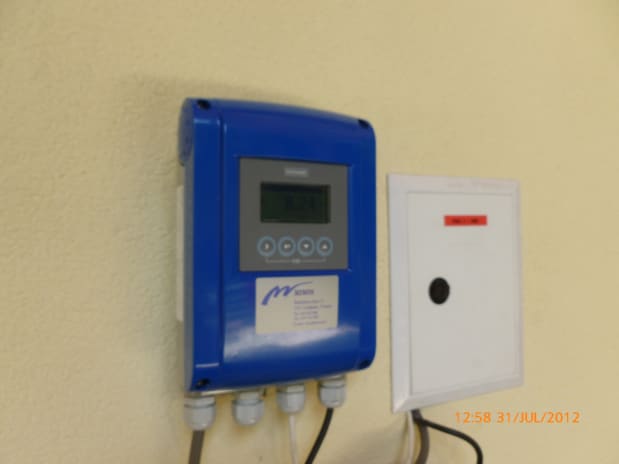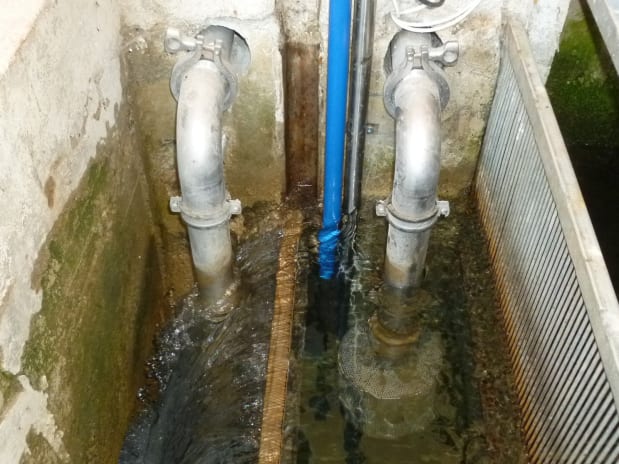Dissolved oxygen monitoring at fish farm
Application Report | Water & Wastewater
- Raising of food fish (40 t) in water channel
- Optical analysis of dissolved oxygen content in the river water supply
- Alarm release in the event of limit value exceedance

Background
Ribogojstvo Goričar runs a fish farm in Podbočje, Slovenia, where food fish is raised commercially in a channel supplied with water by an adjacent river. The fish farm is separated into various basins with a total fish stock of 40 tons. It takes two years of growing until the fish is ready to be harvested and sold on the domestic fish market.
Measurement requirements
Preserving the fish stock and keeping the quality of the fish as high as possible depends considerably on a constant amount of dissolved oxygen (O2) in the water of the fish-raising channel. The amount of dissolved oxygen changes every season and can vary from an optimum 7-8 mg/l in summer to a maximum 10 mg/l in winter. If the amount of dissolved oxygen sinks below a critical limit of 4-5 mg/l due to leaks or water pollution, a fish die-off may occur within minutes. To prevent a total loss of the fish stock through oxygen shortage, Ribogojstvo Goričar has so far calculated the amount of oxygen by rule of thumb while regulating the oxygen supply manually. The fish farming company also used to control the water level by using an ultrasonic level meter which, however, didn’t produce reliable measuring results. Therefore the company was looking for a suitable sensor to be able to measure the water quality automatically and monitor the dissolved O2 on a regular basis.
KROHNE Solution
The KROHNE sales representative recommended installation of the optical sensor OPTISENS ODO 2000 for the direct measurement of dissolved oxygen. The analysis instrument is installed in the immersion holder SENSOFIT IMM 2000, measuring right next to the water inlet where the aquaculture is supplied with river water. Media flow is not required.
With the OPTISENS, a flourescent dye (luminophore) is stimulated by a short wavelength light source. When the luminophore returns to its original state, light with a longer wavelength is emitted. If oxygen is contacting the luminophore the time shift of back scattering the light is shortened according to the oxygen concentration on the membrane. The time between light being transmitted by the luminophore and it being recorded is used for measuring the amount of oxygen. The value is converted into a current output of 4…20 mA and displayed by the signal converter MAC 100, which provides a graph showing the oxygen content over the last hour. The signal converter is connected to a SCADA system that sends an alert via sms to a supervisor when the oxygen level is about to fall below 5mg⁄I.
Customer benefits
Using the OPTISENS ODO 2000 Ribogojstvo Goričar no longer risks losing its fish stock through oxygen undersupply. The fish farm operator stands to gain from a much better ability to respond. They can now take immediate steps to keep the concentration of oxygen above 5mg⁄I, thus ensuring ideal fish raising conditions. The graph displayed by the MAC 100 was a particular benefit here as the development of the oxygen level over a specified time period can now be monitored at any time. The automated measurement is far more accurate than a manual measurement, which can deviate up to 1mg⁄I. Thus, the fish farm can be run more economically. As it is no longer necessary for the customer to regulate the oxygen content by rule of thumb, an expensive oxygen delivery is carried out only when it is really required. The OPTISENS ODO 2000 doesn’t need any recalibration and offers long-term stability. Due to its integrated spray cleaning system there is no need for manual cleaning.




